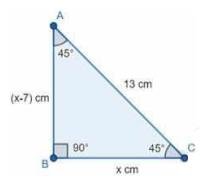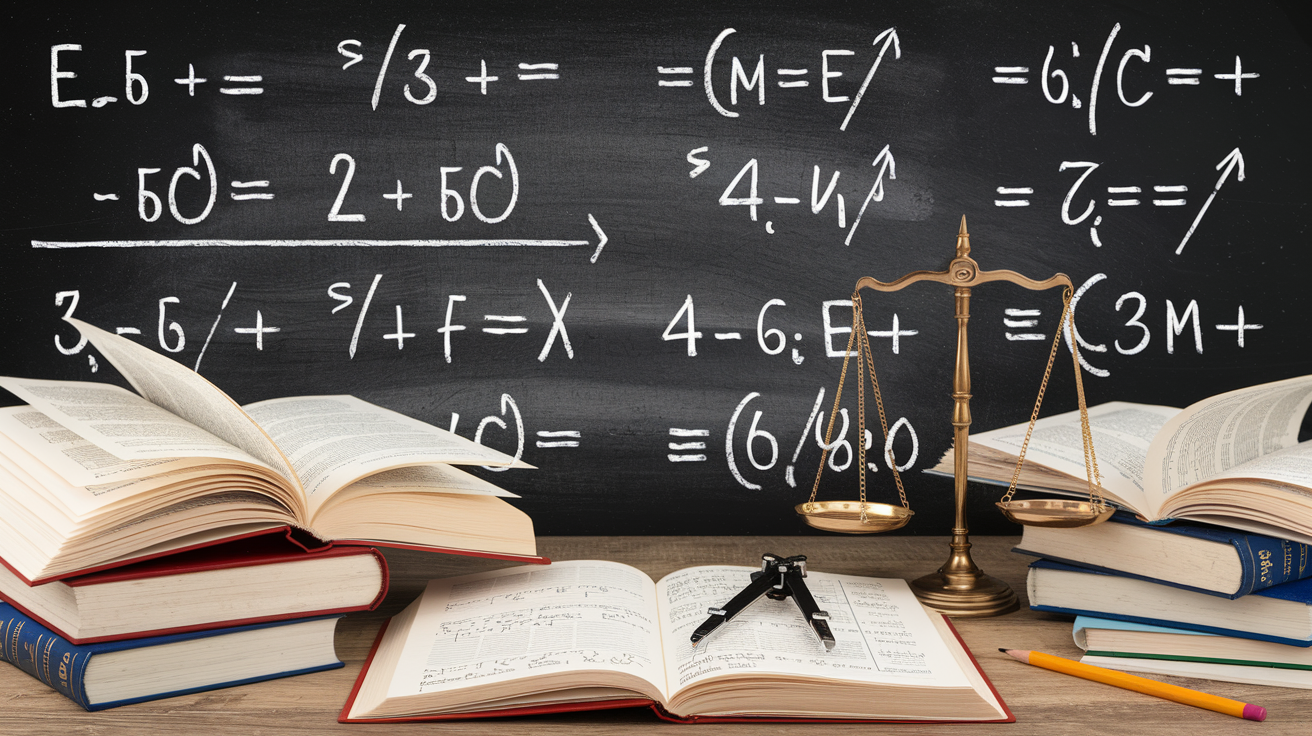
(ii) A cottage industry produces a certain number of toys in a day. The cost of production of each toy (in rupees) was found to be 55 minus the number of toysproduced in a day. On a particular day, the total cost of production was` 750. We would like to find out the number of toys produced on that day.
Answer
(ii) Let the number of toys produced be x.\( \therefore \) Cost of production of each toy \( =\mathrm{Rs}(55-\mathrm{x}) \)
It is given that, total production of the toys \( = \) Rs 750 \[\therefore \mathrm{x}(55-\mathrm{x})=750 \\ \Rightarrow \mathrm{x}^{2}-55 \mathrm{x}+750=0 \] Now to factorize this equation we have to find two numbers such that their product is 750 and sum is 55 \[\Rightarrow x^{2}-25 x-30 x+750=0 \\ \Rightarrow x(x-25)-30(x-25)=0 \\ \Rightarrow(x-25)(x-30)=0\]
Either \( \mathrm{x}-25=0 \) or \( \mathrm{x}-30=0 \)
i.e., \( x=25 \) or \( x=30 \)
Hence, the number of toys will be either 25 or 30 .
CBSE Class 10 Maths Chapter 4 Quadratic Equations Ex 4.2 || NCERT Solutions for Class 10 Maths Chapter 4: Quadratic Equations (English Medium)
Download the Math Ninja App Now3. Find two numbers whose sum is 27 and product is 182 .
Answer
Let the first number be x and the second number is \( 27-\mathrm{x} \).[As the sum of both the numbers is 27]
Therefore, their product \( =\mathrm{x}(27-\mathrm{x}) \)
It is given that the product of these numbers is 182 .
\( x(27-x)=182\)
\(-x^{2}+27 x-182=0\)
Changing the signs on both sides we get, \( \mathrm{x}^{2}-27 \mathrm{x}+182=0 \)
Factorizing we get, 13 and 14 are the numbers whose sum is 27 and product is 182
\( x^{2}-13 x-14 x+182=0\)
\(=x(x-13)-14(x-13)=0\)
\( =(x-13)(x-14)=0 \)
Either \( \mathrm{x}-13=0 \) or \( \mathrm{x}-14=0 \)
i.e., \( x=13 \) or \( x=14 \)
If first number \( =13 \), then
Other number \( =27-13=14 \)
If first number \( =14 \), then
Other number \( =27-14=13 \)
Therefore, the numbers are 13 and 14.
4. Find two consecutive positive integers, sum of whose squares is 365 .
Answer
To Find: Consecutive integers sum of whose square is 365. Consecutive integers mean that the difference between the integers is of 1 Let the consecutive positive integers be \( x \) and \( x+1 \).Given that \( \mathrm{x}^{2}+(\mathrm{x}+1)^{2}=365 \)
\( \Rightarrow x^{2}+x^{2}+1+2 x=365\)
\(\Rightarrow 2 x^{2}+2 x-364=0\)
\(\Rightarrow x^{2}+x-182=0\)
Now to factorize the above quadratic equation, we need to
chose numbers such that their product is 182 and difference is 1.
\( \Rightarrow \mathrm{x}^{2}+14 \mathrm{x}-13 \mathrm{x}-182=0\)
\(\Rightarrow \mathrm{x}(\mathrm{x}+14)-13(\mathrm{x}+14)=0\)
\((\mathrm{x}+14)(\mathrm{x}-13)=0\)
Either \( x+14=0 \) or \( x-13=0 \), i.e., \( x=-14 \) or \( x=13 \)
Since the question ask for positive integers, \( x \) can only be 13 .
\( \therefore x+1=13+1=14 \)
Therefore, two consecutive positive integers will be 13 and 14 .
5. The altitude of a right triangle is 7 cm less than its base. If the hypotenuse is 13 cm , find the other two sides.
Answer
Consider a right angle \( \triangle \mathrm{ABC} \)
Let the base of the \( \Delta \) be \( x \)
\( \Rightarrow \) Altitude \( =\mathrm{x}-7 \)
In the right-angled triangle
According to the Pythagoras theorem
\( (\text { Hypotenuse })^{2}=(\text { base })^{2}+(\text { altitude })^{2} \)
\( \Rightarrow 13^{2}=x^{2}+(x-7)^{2}\)
\(\Rightarrow 169-x^{2}-x^{2}-49+14 x=0\)
\(\Rightarrow 2 x^{2}-14 x-120=0\)
\(\Rightarrow x^{2}-7 x-60=0\)
\(\Rightarrow x^{2}-12 x+5 x-60=0\)
\( \Rightarrow \mathrm{x}(\mathrm{x}-12)+5(\mathrm{x}-12)=0\)
\(\Rightarrow(\mathrm{x}+5)(\mathrm{x}-12)=0\)
\(\Rightarrow \mathrm{x}=-5 \text { or } 12\)
But base cannot be negative, so \( x=12 \mathrm{~cm} \)
\( \Rightarrow \text { altitude }=12-7=5 \mathrm{~cm} \)
Hence 5 cm and 12 cm are the two sides of the given triangle.
CBSE Class 10 Maths Chapter 4 Quadratic Equations Ex 4.2 || NCERT Solutions for Class 10 Maths Chapter 4: Quadratic Equations (English Medium)
Download the Math Ninja App Now6. A cottage industry produces a certain number of pottery articles in a day. It was observed on a particular day that the cost of production of each article (in rupees) was 3 more than twice the number of articles produced on that day. If the total cost of production on that day was Rs 90, find the number of articles produced and cost of each article.
Answer
To find: Number of articles produced and cost of each article.Let the number of articles produced be \( x \).
Therefore, cost of production of each article \( = \) Rs \( (2 x+3) \)
The total cost of production \( = \) Total quantity produced x cost of one article.
It is given that the total cost of production is Rs 90.
\(\therefore \mathrm{x}(2 \mathrm{x}+3)=90\)
\(\Rightarrow 2 \mathrm{x}^{2}+3 \mathrm{x}=90\)
\(\Rightarrow 2 \mathrm{x}^{2}+3 \mathrm{x}-90=0\)
\(\Rightarrow 2 \mathrm{x}^{2}+15 \mathrm{x}-12 \mathrm{x}-90=0\)
\(\Rightarrow \mathrm{x}(2 \mathrm{x}+15)-6(2 \mathrm{x}+15)=0\)
\(\Rightarrow(2 \mathrm{x}+15)(\mathrm{x}-6)=0\)
Either \( 2 x+15=0 \) or \( x-6=0 \),
i.e., \( x=\frac{-15}{2} \) or \( x=6 \)
As the number of articles produced can only be a positive
integer, Therefore, \( x \) can only be 6 .
Hence, the number of articles produced \( =6 \)
Cost of each article \( =2 \times 6+3 \)
\( =12+3=\operatorname{Rs} 15 \text {. } \)
CBSE Class 10 Maths Chapter 4 Quadratic Equations Ex 4.2 || NCERT Solutions for Class 10 Maths Chapter 4: Quadratic Equations (English Medium)
Download the Math Ninja App NowCentral Board of Secondary Education Official Site
Class 10 : NCERT Solutions for Class 10 Maths Chapter 1 Exercise 1.1
Class 10 : NCERT Solutions for Class 10 Maths Chapter 1 Exercise 1.2
Class 10 : NCERT Solutions for Class 10 Maths Chapter 1 Exercise 1.3
Class 10 : CBSE Class 10 Maths Chapter 2 Polynomials Ex 2.1
Class 10 : CBSE Class 10 Maths Chapter 2 Polynomials Ex 2.2
Class 10 : CBSE Class 10 Maths Chapter 2 Polynomials Ex 2.4
Class 10 : CBSE Class 10 Maths Chapter 3 Pair of Linear Equations in Two Variables Ex 3.1
Class 10 : CBSE Class 10 Maths Chapter 3: Pair of Linear Equations in Two Variables || CBSE Class 10 Maths Chapter 3 Pair of Linear Equations in Two Variables solutions Ex 3.2
Class 10 : CBSE Class 10 Maths Chapter 3: Pair of Linear Equations in Two Variables || CBSE Class 10 Maths Chapter 3 Pair of Linear Equations in Two Variables solutions Ex 3.3
Class 10 : CBSE Class 10 Maths Chapter 3: Pair of Linear Equations in Two Variables || CBSE Class 10 Maths Chapter 3 Pair of Linear Equations in Two Variables solutions Ex 3.4
Class 10 : CBSE Class 10 Maths Chapter 3: Pair of Linear Equations in Two Variables || CBSE Class 10 Maths Chapter 3 Pair of Linear Equations in Two Variables solutions Ex 3.5
Class 10 : CBSE Class 10 Maths Chapter 3: Pair of Linear Equations in Two Variables || CBSE Class 10 Maths Chapter 3 Pair of Linear Equations in Two Variables solutions Ex 3.6
Class 10 : CBSE Class 10 Maths Chapter 5 Arithmetic Progressions Ex 5.3
Class 10 : NCERT Solutions for Class 10 Maths Chapter 8 Exercise 8.2
Class 10 : CBSE Class 10 Maths Chapter 10 Circles solutions Ex 10.2
Class 10 : CBSE Class 10 Maths Chapter 13 Surface Areas and Volumes solutions Ex 13.2

